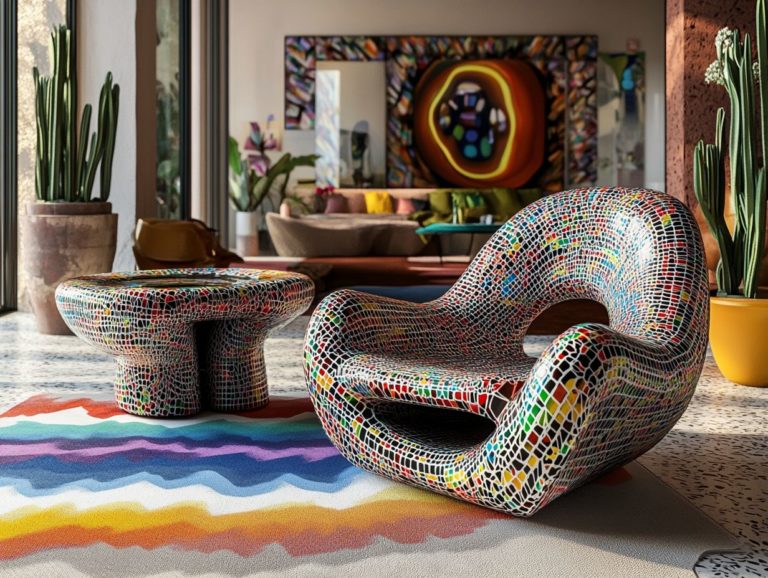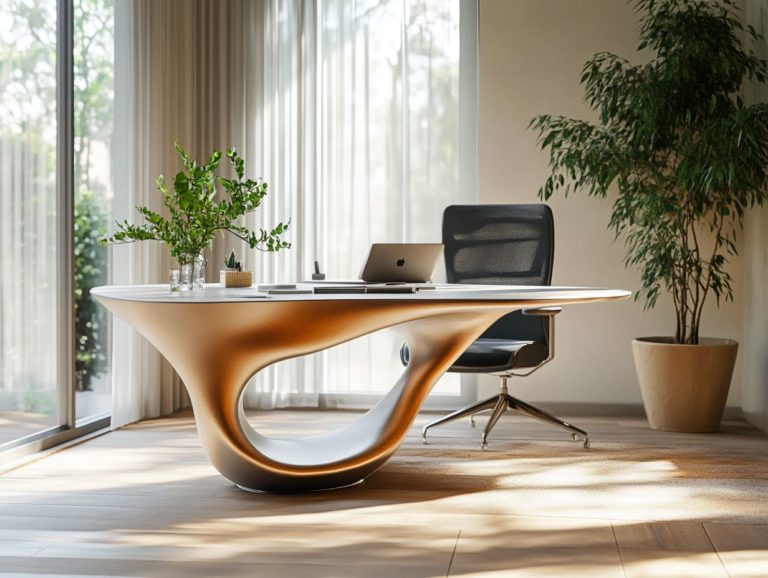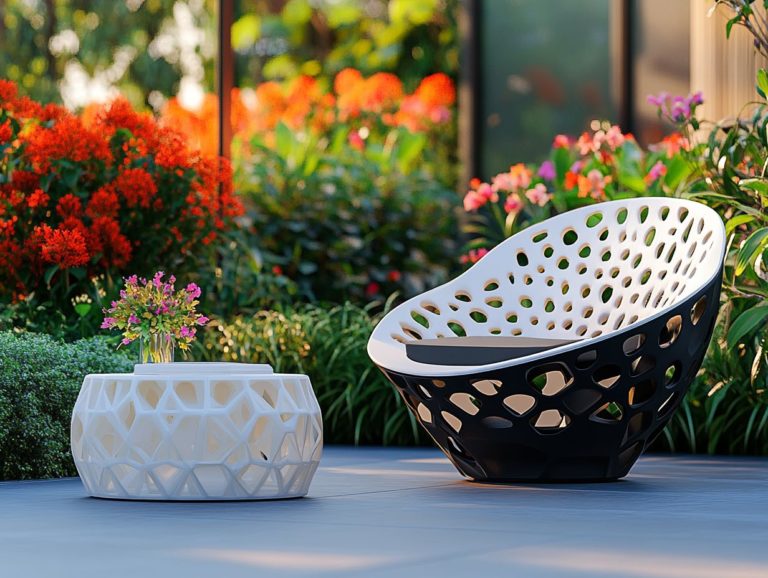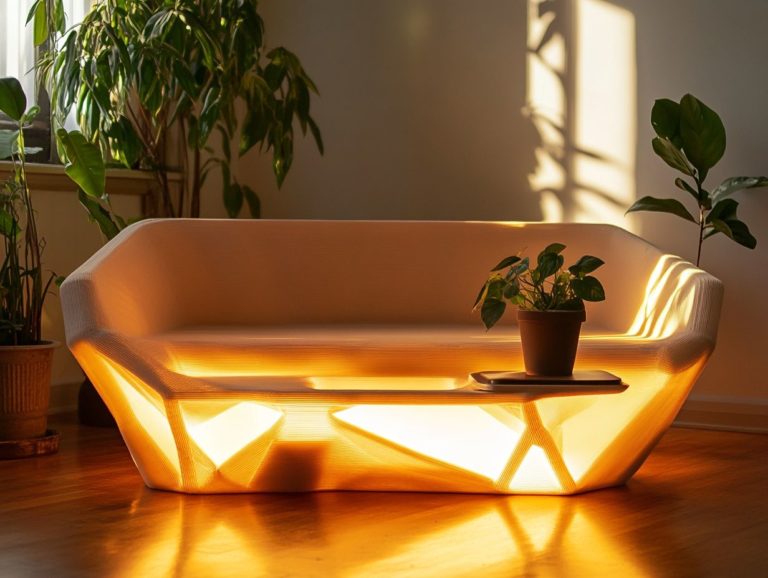5 Creative Ways to Use 3D-Printed Furniture
Personalized 3D-printed furniture is changing how you decorate your home. Get ready to explore five exciting ways to use this innovative technology.
This article invites you to explore five imaginative ways to leverage the power of 3D printing from bespoke designs that mirror your unique style to space-saving solutions ideal for urban living.
You ll discover the myriad benefits of sustainability, affordability, and functionality, all while learning how to embark on your own design journey.
Dive in and discover the exhilarating future of 3D-printed furniture!
Contents
Key Takeaways:
1. Customized Home Decor
Customized home decor offers a transforming experience in the furniture industry, where 3D printing technology allows you to craft unique pieces perfectly suited to your aesthetic preferences and functional needs. By harnessing digital craftsmanship which allows for precise design and customization through software designers can delve into a multitude of creative possibilities, ensuring that each item resonates deeply with your artistic vision and lifestyle choices.
This technology gives you the power to reimagine traditional furniture design, enabling you to create everything from intricate coffee tables to bespoke lighting fixtures that align seamlessly with your personal tastes. Picture a sleek shelf that perfectly complements the contours of your room’s architecture or a vibrant chair that mirrors the mood of its surrounding decor.
Digital modeling plays a pivotal role in this process, allowing designers to visualize and refine their creations with remarkable precision before bringing them to life. Ultimately, customized home decor not only elevates aesthetic appeal but also nurtures a profound connection between you and your living space.
2. Space-Saving Solutions
Space-saving solutions have emerged as a cornerstone of modern furniture design, especially in urban environments where functionality and aesthetic appeal must coexist. In fact, 5 ways 3D-printed furniture can save you money highlight how new printing methods make this possible.
Imagine a compact coffee table that effortlessly transforms into a dining surface, crafted with comfortable shapes to enhance your comfort while using it. Picture a multi-use chair that adjusts to various seating configurations, featuring a sleek design that complements modern decor while maximizing your space.
These clever pieces not only showcase the artistry enabled by 3D printing but also meet the rising demand for versatile, stylish furniture that adapts seamlessly to smaller living spaces. To learn more about incorporating these innovative designs, check out our guide on how to style your space with 3D-printed furniture. These designs combine practicality with creativity, elevating the ambiance of any room and making your home both functional and inviting.
3. Unique and Functional Designs
Unique and functional designs in furniture are becoming increasingly attainable thanks to advancements in 3D printing. This technology provides 5 reasons to choose 3D-printed furniture, allowing you to create pieces that are not only visually striking but also serve practical purposes.
With 3D printing, you can craft intricate geometries and unique textures that traditional manufacturing methods simply can’t match. You have the freedom to explore your artistic vision without the limitations of conventional techniques, resulting in dynamic furniture that beautifully balances form and function. For those looking to create their own pieces, consider these 5 tips for designing your own 3D-printed furniture. Imagine a coffee table with an organic shape that mimics natural forms or an intricately textured chair that invites a tactile experience.
These innovations allow you to blend creativity with utility, enriching your living spaces with striking, personalized furnishings that truly reflect your individuality.
4. Sustainable and Eco-Friendly Options

Sustainable and eco-friendly options in furniture manufacturing are on the rise. 3D printing leads the way by using upcycled materials and innovative techniques that significantly reduce environmental impact.
This shift is crucial as you, the discerning consumer, increasingly seek products that fulfill your aesthetic desires and resonate with your values surrounding environmental responsibility. By embracing 3D printing technology, manufacturers can effectively minimize waste. They create products that are easily disassembled and reassembled, fostering a circular economy.
Consider projects like the Reclaimed Wood Bench, which exemplifies how discarded timber can be transformed into stylish and durable furniture. Similarly, companies like Kormendi Design showcase the potential of recycled plastics, presenting chic, modern seating through 3D printing.
These examples paint a promising picture of a future where sustainability and innovation seamlessly intertwine.
5. Affordable and Accessible Furniture
Affordable and accessible furniture solutions are revolutionizing the market, largely due to advancements in 3D printing technologies that streamline product development and manufacturing processes.
By significantly cutting production costs and time, 3D printing gives you the power to experiment with innovative materials that enhance both functionality and aesthetics. This democratization of high-quality furniture means you now have access to bespoke options that were once the exclusive domain of high-end markets. This fosters creativity and personalization in your choices.
For designers, the ability to produce custom pieces quickly opens up exciting new business opportunities and encourages collaboration. As this technology continues to evolve, it transforms how furniture is conceived and produced. It also reshapes the relationship between makers and consumers, paving the way for a more engaged and vibrant community.
Don t miss out on the chance to explore these incredible options today!
What Is 3D Printing and How Does It Work?
3D printing is a groundbreaking technology. It allows you to create three-dimensional objects layer by layer from digital models. This innovation gives you amazing freedom to design and choose materials across various industries, including furniture design.
With this technology, you can transform intricate concepts into tangible products. It streamlines your prototyping process and significantly reduces the time it takes to bring an idea to market. By leveraging special software for designing, you can explore complex shapes and ergonomics that traditional methods might limit.
Take, for instance, the ability to produce bespoke chairs and tables that adapt to a user s environment or personal style this modern technique truly champions personalization. Plus, the sustainability factor, where materials can be sourced responsibly or recycled, adds another layer of importance, promoting environmentally friendly practices in product development.
What Are the Advantages of Using 3D-Printed Furniture?
3D-printed furniture offers exciting benefits! You gain advantages like enhanced customization, rapid prototyping capabilities, and the opportunity to explore stylish 3D-printed furniture solutions that traditional manufacturing simply can’t accommodate.
Among these compelling features, cost-effectiveness stands out, allowing you to produce high-quality pieces without the hefty price tag typically associated with bespoke options. Design flexibility means you can create unique shapes and forms tailored to your specific needs or spaces, unleashing your creative potential as a designer or consumer.
The reduced production waste in 3D printing not only supports environmental sustainability but also streamlines the supply chain. This evolution is reshaping your expectations of modern furniture.
How Can One Design Their Own 3D-Printed Furniture?

Designing your own 3D-printed furniture opens up exciting possibilities. With advanced software, you can create pieces that reflect your style.
Start by choosing the right software, such as Tinkercad or Fusion 360. Understanding principles like balance and ergonomics will make your designs both beautiful and functional. Embrace the iterative nature of prototyping to refine your designs based on printed results.
As a beginner, focus on simple geometric shapes to build your confidence. Keeping an eye on trending aesthetics can spark unique innovations and transform your design journey into a rewarding experience.
What Materials Can Be Used for 3D-Printed Furniture?
You have many material options for 3D-printed furniture. PLA and bioplastics are popular choices that look great and support sustainable production.
Consider using recycled nylon or wood filament for unique textures. These materials help reduce waste and lower carbon footprints.
By choosing sustainable materials, you can bring your creative visions to life while taking a stand against environmental degradation. This positions you at the forefront of the circular economy, aligning your furniture production with eco-friendly values and responsible sourcing.
What Are the Limitations of 3D-Printed Furniture?
3D-printed furniture has its challenges, and understanding how to incorporate 3D-printed furniture in your decor is essential, as issues like design complexity and material strength can affect usability.
These challenges often stem from the qualities of the printing processes and materials used, leading to products that may not match the robustness of traditional manufacturing. Inconsistencies in surface finish may also diminish visual appeal. Restrictions in design complexity can limit creativity.
However, advancements in technology, like improved material formulations and printing techniques, hold great promise. Innovations will enhance both the functional and aesthetic qualities of 3D-printed furniture, making it more appealing to consumers.
What Is the Future of 3D-Printed Furniture?
The future of 3D-printed furniture is bright and full of possibilities. Sustainable and customizable designs are becoming the norm.
As you explore this landscape, you’ll see designers embracing biodegradable materials and solar-powered printers. This shift marks a significant move toward eco-friendly practices.
The integration of smart technology enhances user experience and functionality, catering to a growing desire for personalized furnishings. By merging these elements with architectural design, we’re looking at the potential for seamless, space-efficient solutions.
This evolution not only reflects changing consumer preferences but also positions 3D printing as a key player in crafting a sustainable future for furniture design.
Ready to start your 3D printing journey? Dive in and create your masterpiece today!
Frequently Asked Questions
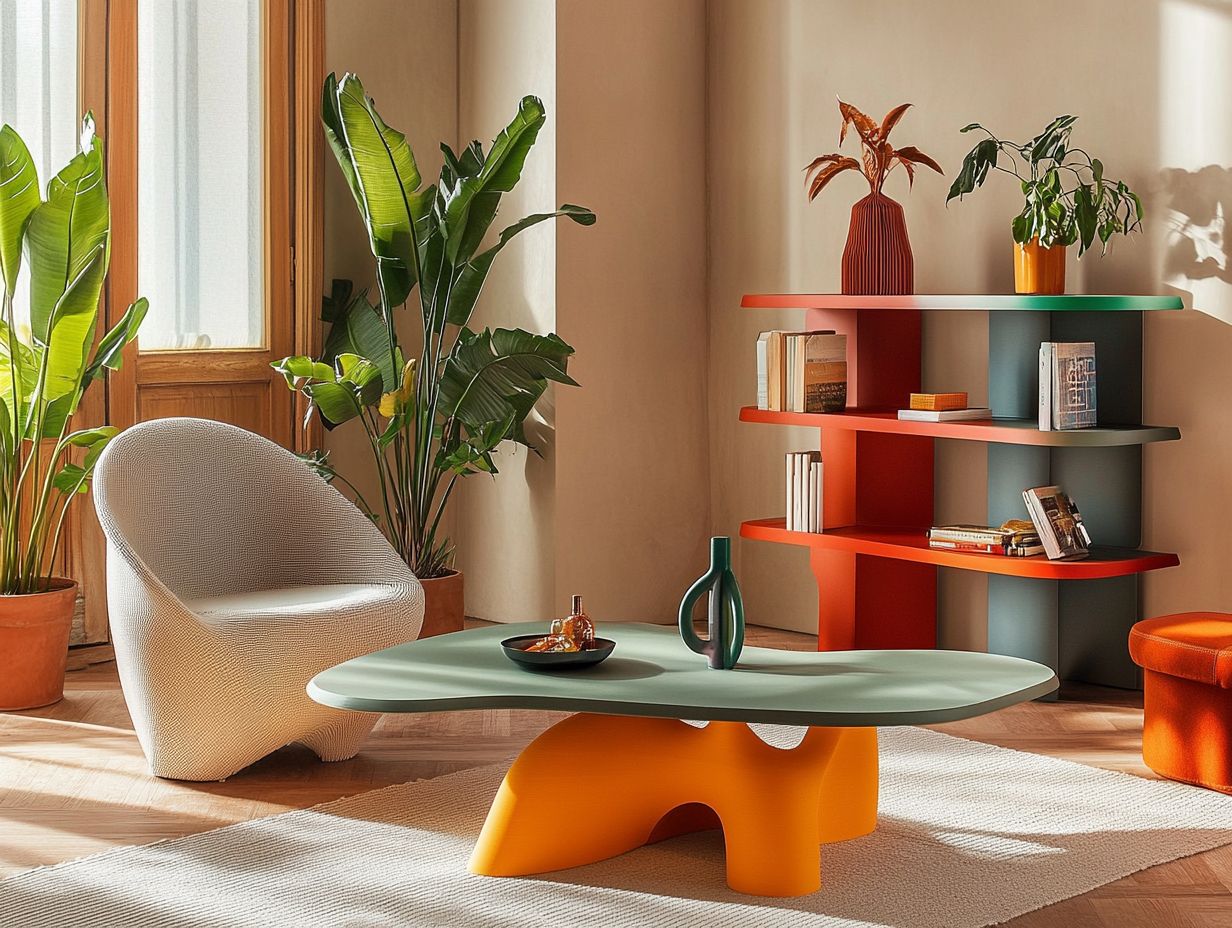
What is 3D-printed furniture?
3D-printed furniture is furniture that is made using a 3D printer, which works by creating a 3D object from a digital model by laying down successive layers of material.
What are some benefits of using 3D-printed furniture?
3D-printed furniture offers customization and personalization.
It is also sustainable, using fewer resources and producing less waste.
Lastly, it can be more cost-effective than traditional furniture manufacturing methods.
Can 3D-printed furniture be used for everyday purposes?
Yes, 3D-printed furniture can be used for everyday purposes just like traditional furniture. It is durable and can hold weight, making it suitable for use as chairs, tables, and other household items.
What are some creative ways to use 3D-printed furniture?
Imagine having unique 3D-printed furniture in your home! You can use it for outdoor seating, create unique decor pieces, or even explore how to decorate with 3D-printed furniture to incorporate it into art installations that will catch everyone’s eye.
Is it difficult to maintain 3D-printed furniture?
No, it is not difficult to maintain 3D-printed furniture. It can be cleaned and maintained just like any other piece of furniture.
However, it is important to follow the specific care instructions provided by the manufacturer.
Can 3D-printed furniture be recycled?
Yes, 3D-printed furniture can be recycled. Most 3D printing materials are made from recyclable plastic, making it a sustainable option for furniture.
However, it is important to check with the manufacturer for specific recycling instructions.


